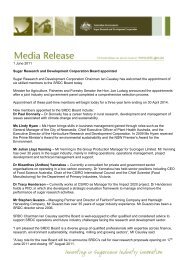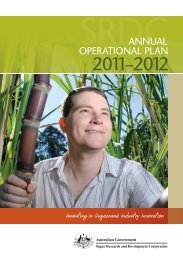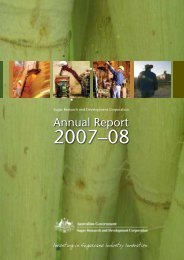Section 2 - Sugar Research and Development Corporation
Section 2 - Sugar Research and Development Corporation
Section 2 - Sugar Research and Development Corporation
Create successful ePaper yourself
Turn your PDF publications into a flip-book with our unique Google optimized e-Paper software.
58<br />
PEOPLE DEVELOPMENT<br />
Individual Capacity Building Projects (CBPs) completed during 2010–2011<br />
Project<br />
number<br />
People development<br />
Key<br />
Performance<br />
Indicator<br />
<strong>Research</strong>er <strong>and</strong> Organisation Project objective<br />
UQ046 Kimberley Tilbrook, UQ To attend the meeting of the International Symposium<br />
on BioPolymers in Stuttgart, Germany <strong>and</strong> present PhD<br />
research.<br />
BSS340 Nader Sallam, BSES Limited To participate in the 8th Entomology Workshop of the<br />
International Society of <strong>Sugar</strong> Cane Technologists in<br />
Mauritius <strong>and</strong> visit research sugarcane centres <strong>and</strong> industry<br />
establishments in Mauritius <strong>and</strong> Reunion.<br />
SRD032 Mark Whitten <strong>and</strong> Am<strong>and</strong>a<br />
Vickers<br />
Enhanced effectiveness<br />
of partnerships <strong>and</strong> networks<br />
contributing to the sugarcane<br />
industry<br />
Measure Demonstration of improved<br />
capability <strong>and</strong> capacity of<br />
regional groups, networks, <strong>and</strong><br />
industry sectors <strong>and</strong> researchers<br />
to collaborate <strong>and</strong> innovate to<br />
benefi cially change the operation<br />
of the industry.<br />
Pre-treatment of sugarcane<br />
This project was conducted primarily by three<br />
James Cook University Bachelor of Engineering<br />
students as their fourth-year projects.<br />
Of the total energy expended in a typical sugar<br />
mill, about 30 per cent is used to prepare cane<br />
for crushing using high-speed shredders that<br />
release the juice from cells. Shredders require<br />
considerable maintenance because of their<br />
high-wear environment. This project examined<br />
microwave energy to open the sugarcane cells<br />
rather than relying on shredders.<br />
SRDC Annual Report 2010–2011<br />
Scholarship for two people to attend the Training Rural<br />
Australians in Leadership 2010 course.<br />
BSS337 Dr Priya Joyce, BSES Limited To visit two leading sugarcane research institutes in China<br />
<strong>and</strong> to present two talks at the Gaungzhou <strong>Sugar</strong>cane<br />
Industry <strong>Research</strong> Institute <strong>and</strong> three talks at Fujian<br />
<strong>Sugar</strong>cane Genetics <strong>and</strong> Breeding Laboratories in Fujian.<br />
Microwave treatment signifi cantly reduced the<br />
compressive strength of sugar cane making it<br />
easier to crush <strong>and</strong> as result around 60 per cent<br />
of energy can be saved during the crushing<br />
process.<br />
The students were successful in showing that<br />
there could be considerable savings in energetic<br />
cost of extracting juice by pre-treating sugarcane<br />
using microwave energy, compared to the<br />
conventional shredding <strong>and</strong> milling processes.<br />
The new technology will assist to reduce the<br />
amount of electricity needed for processing<br />
<strong>and</strong> thereby maximise the available bagasse for<br />
energy co-generation. This will have a signifi cant<br />
impact on the sugarcane industry <strong>and</strong> sugarcane<br />
growers as the burning of bagasse as a fuel is a<br />
green house positive process (JCU030).






